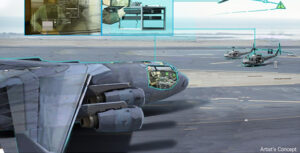 WASHINGTON: As DARPA nears its annual August release of new projects for the coming fiscal year, DoD’s cutting-edge research arm is looking to pump up efforts to improve the reliability, and trustworthiness, of AI-based systems.
WASHINGTON: As DARPA nears its annual August release of new projects for the coming fiscal year, DoD’s cutting-edge research arm is looking to pump up efforts to improve the reliability, and trustworthiness, of AI-based systems.
“There’s a major issue with the robustness of these technologies,” Peter Highnam, DARPA’s acting director, told the Defense Writers Group today. “There’s so many different application areas and there’s so much that needs to be done to make the current AI technologies robust — and to figure out, and to explore and define, what the next wave of AI technologies are, what the emphasis will be.”

Peter Highnam
As an example, he said, although the science of neural nets is well know and being applied across both military and civilian systems, there isn’t a clear understanding of how they evolve and at what point they are fully reliable.
“Neural nets, and reinforcement learning and the things around that, are very big and being applied in many places, but they’re not robust yet. Training these things and retraining them, for example, is still a bit of black art,” he explained. “Formal verification — with the notion of flying in or trusting your life to decisions being made by a system autonomously — today, I wouldn’t do it without having humans involved, without having controllers.”
One of the problems in building more reliable and predictable AI, he explained, is the lack lack of commonly agreed methodologies for AI systems engineering. “There is no discipline of AI systems yet,” he said bluntly. “That’s why we’re doing some of the legwork, but others outside need to do that too.”
For example, Highnam said, one of DARPA’s projects aimed at creating a robust, reliable AI systems is focused on AI-enabled flight control systems to allow it to adapt to anomalous and/or dangerous conditions, and guarantee that it can keep the plane “within a feasible fight control envelope.”

Artist’s rendition of DARPA’s ALIAS AI flight control system
According to DARPA’s website, the Aircrew Labor In-Cockpit Automation System (ALIAS) program “envisions a tailorable, drop-in, removable kit that would promote the addition of high levels of automation into existing aircraft, enabling operation with reduced onboard crew.” It adds that ALIAS “aims to support execution of an entire mission from takeoff to landing, even in the face of contingency events such as aircraft system failures.”
Another area where DARPA is seeking to build more robust artificial intelligence is in relation to 5G wireless networks, which governments and militaries around the world are rushing to put in place to underpin the Internet of Things. “We’re doing some very, very interesting leading work — with challenges actually — bringing AI to 5G technologies,” Highnam said.
DARPA in 2018 decided to invest $2 billion over five years to increase its AI portfolio, an effort called AI Next. It also is working hand-in-glove with the Joint Artificial Intelligence Center (JAIC), and the service labs, Highnam said. This includes the “AI Explorations” initiative to rope in talent from universities before masters students and post-doc researchers get snapped up by the private sector, where academics can respond to DARPA’s topics of interest and be on contract for a study within 90 days.
 “I think that one of the key differences now is that we see in DoD — you mentioned the JAIC and there are other organizations too — they’re now set up to actually deploy, productize and sustain our AI R&D developments into the field,” DARPA’s acting deputy director David Honey chimed in. “And I find that to be a very exciting development that wasn’t there before. That was desperately needed.”
“I think that one of the key differences now is that we see in DoD — you mentioned the JAIC and there are other organizations too — they’re now set up to actually deploy, productize and sustain our AI R&D developments into the field,” DARPA’s acting deputy director David Honey chimed in. “And I find that to be a very exciting development that wasn’t there before. That was desperately needed.”
Other priority areas for investment in 2021, Highnam said, are electronics, 5G, and space, as well as adding a bit more focus on directed energy and quantum science.
Finally, DARPA is more and more interested in what he called “operational biology” — “things that other people are probably not going to be getting into, that we need to find out what can be done there to really help the department.”
To illustrate what operational biology means, he said that he often brings along a brick to his presentations as a prop — not just an ordinary brick, but one that has been “grown, not concrete” through synthetic biology.
“It’s the notion of being able to produce a landing pad for a helicopter, not by bringing in heavy gear and pouring cement to lay that down … but they’re coming in and spraying it onto gravel or sand or whatever is there, and within a few days, having a landing pad in place,” he said.
“So, there are so many opportunities that, again, are outside the comfort zone of other places that DARPA is going to continue to get into and de risk,” Highnam added enthusiastically. “That’s the nature of the DARPA machine.”
Under its normal funding cycle, DARPA posts its chosen research opportunities around Aug. 1, with responses due mid-fall. Contracts are awarded fairly rapidly, assuming the annual defense budget has been approved. This nominally should happen before the Sept. 30 of the fiscal year, but rarely does — and this year the always contentious budget deliberations are complicated by the COVID-19 pandemic and the pending presidential election.
Norway’s top officer on his ‘biggest challenge,’ next frigate and new NATO neighbors
Gen. Eirik Kristoffersen, Norway’s Chief of Defense, talks to Breaking Defense about his plans for spending on new frigates and subs, the challenges of upgrading Norway’s “digital backbone” and refilling the military’s stocks.



























